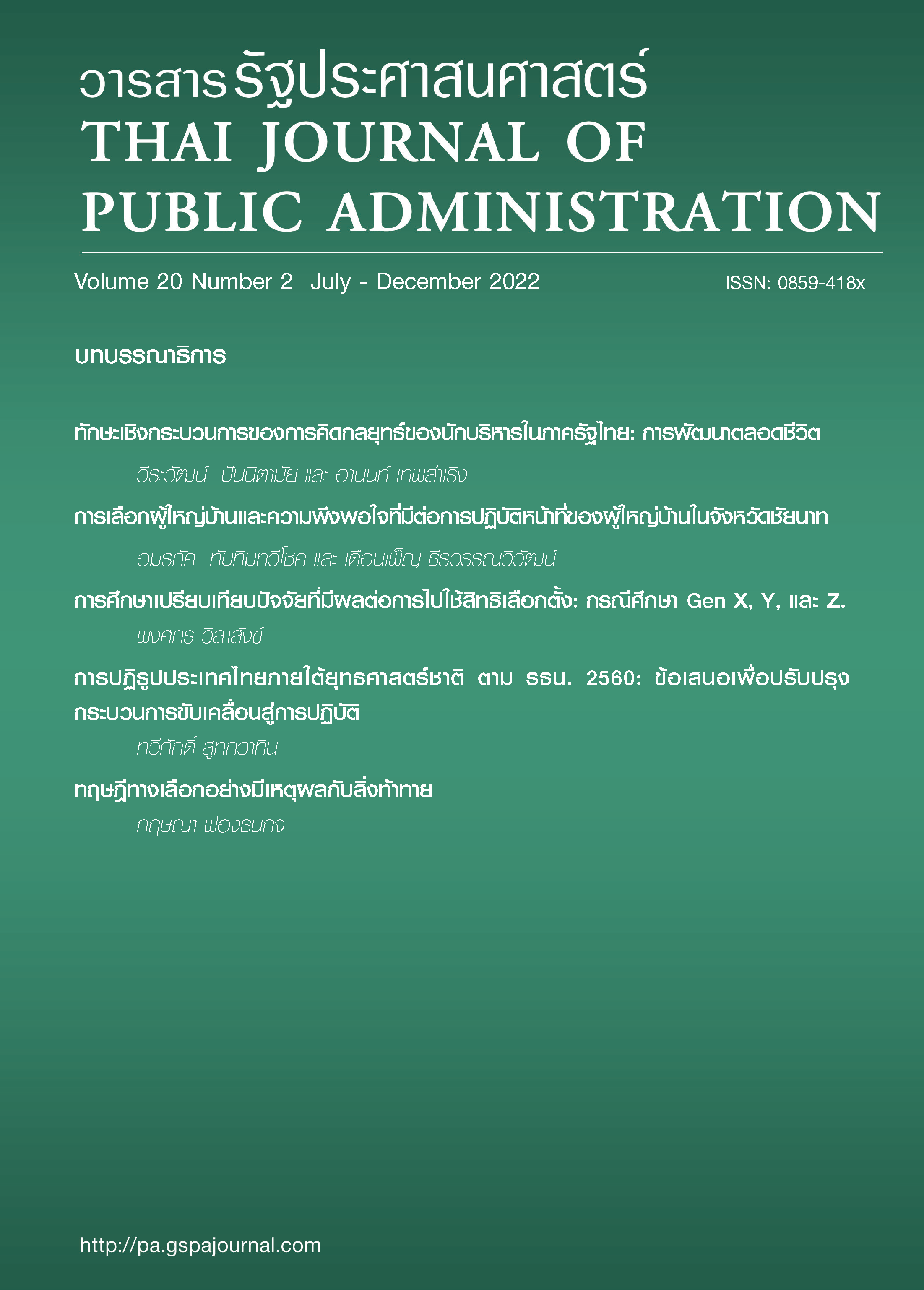Process Skills on Strategic Thinking among Thai Public Executives: A Life-Long Development
Keywords:
Strategic thinking, a process model of strategic thinking, executive developmentAbstract
Senior executives in the public sector are considered a very important civil servant group for country development. Their good intention and broad work experience combined with their capacity of strategic thinking deems critical for effective state functioning. This research study was intended to assess and then compare a process model which consists of six strategic thinking skills, as proposed by Schoemaker, Krupp & Howland (2013), of participants in Thai leadership development programs. The study sample consists of a group of 547 training participants from different organizational culture whom attended the leadership training programs as follows: a number of 371 senior civil service executives, a number of 120 middle-level managers from the Provincial Electricity Authority (PEA), and a number of 55 senior Thai local administration executives.
The data analyses revealed that the senior executives exhibited a considerably high level of strategic thinking across six skills: the sequential abilities used to anticipate, challenge, interpret, decide, align, and learn (mean range = 5.15 – 5.66 of 1-7 Likert rating scale). The two highest mean scores are on the Anticipation and Learning factors with the lowest on the Decision Making in all subgroups. One-way ANOVA exhibited statistically significant on the Anticipation and Alignment Factors (F = 3.598, p = .05; F = 5.290, p = 0.01). A post-hoc paired comparison analysis showed that the both superior significance was due to the higher mean scores of the civil service executive group over that of the PEA group. The t-test statistics of the total sample confirmed the traditional notion that male executives tend to significantly demonstrate higher levels of strategic thinking in three skills over those of the females. The statistically significant results are on the Challenge, Decision Making, and Alignment factors (t-tests = 3.045, p = 0.01; = 3.873, p = 0.00; = 2.215, p = 0.05, respectively).
The study provided a process model for developing executive strategic thinking via the lens of gender difference, team support, and organizational culture. Suggestions on how to design the process development on strategic thinking of the executives including the problems and future research studies are provided as well as the limitations of this study.
References
Amitabh, M. (2012). Strategic Thinking: Is Leadership the Missing Link? Retrieved September 28, 2017 from https://www.iitk.ac.in/infocell/announce/.
Andrews, M., & Manning, N. (2015). A Study of Peer Learning in the Public Sector: Experience, Experiments, and Ideas to Guide Public Practice. Retrieved from https://www.effectiveinstitutions.org/.../Peer_learning_study_final_p5v0.
Benito - Ostolaza, J. M., & Sanchis - Llopis, J. A. (2014). Training strategic thinking: Experimental evidence. Journal of Business Research, 67(5), 785-789.
Dragoni, L., Oh, I., Tesluk, P. E., Moore, O. A., VanKatwyk, P., & Hazucha, J. (2014). Developing leaders’ strategic thinking through global work experience: The moderating role of cultural distance. Journal of Applied Psychology, 99(5), 867-882.
Goldman, E. F., Schlumpf, K. S., & Scott, A. R. (2017). Combining practice and theory to assess strategic thinking. Journal of Strategy and Management, 10(4), 488-504.
Groysberg, B., Lee, J., Price, J., & Cheng, J. Y. (2018). The leader’s guide to corporate culture: How to manage the eight critical elements of organizational life. Harvard Business Review, January-February, 44-52.
Haycock, K., Cheadle, A., & Bluestone, K. S. (2012). Strategic thinking: Lessons for leadership from the literature. Library Leadership & Management, 26(3), 1-18.
Hughes, R. L., Beatty, K. C., & Dinwoodie, D. L. (2014). Becoming a Strategic Leader: Your Role in Your Organization's Enduring Success. San Francisco, CA: Jossey Bass.
Mascarenhas, O. A. J. (2011). Business Transformation Strategies: The Strategic Leader as Innovation Manager. Los Angeles, CA: The SAGE Publication.
Nuntamanop, P., Kauranen, I., & Igel, B. (2013). A new model of strategic thinking competency. Journal of Strategy and Management, 6(3), 242-264.
Olson, A. K., & Simerson, B. K. (2015). Leading with Strategic Thinking: Four Ways Effective Leaders Gain Insight, Drive Change and Get Results. New York: Wiley.
Pannont, T., Chanbanchong, C., & Udomrat, T. (B.E.2559). A model for the development of strategic thinking competency in the deputy directors of primary education area offices. Narasuan University Journal of Education, 18(4), 128-142.
Punnitamai, W. (B.E.2559). An empirical competency analysis of senior executive program participants under the Office of the Civil Service Commission. A research paper proceeding presented on April 1 on the 50th anniversary of National Institute of Development Administration.
_____________. (B.E.2564). Leadership Development: Paradoxes, Principles, & Practices. Nontaburi: Rattanatrai Publishing.
Rumelt, R. (2011). Good Strategy, Bad Strategy: The Difference and Why It Matters. New York: Crown Business.
Sarfraz, H. (2017). Strategic leadership development: Simplified with Bloom’s taxonomy. Industrial and Commercial Training, 49(1), 40-47.
Schoemaker, P.H., Krupp, S., & Howland, S. (2013). Strategic Leadership: The essential skills, Harvard Business Review, January-February, 131-134.
Somdet Phra Buddhachosacariya (Bhikkhu P.A. Payutto). (B.E.2559). Buddhadhamma: The Laws of Nature and Their Benefits to Life. Translated by Robin Moore. Bangkok: Buddhaadham Foundation.
Zabriskie, N. B., & Huellmantel, A. B. (1991). Developing strategic thinking in senior management. Long Range Planning, 24(6), 25-32.
Downloads
Published
Issue
Section
License

This work is licensed under a Creative Commons Attribution-NonCommercial-NoDerivatives 4.0 International License.



